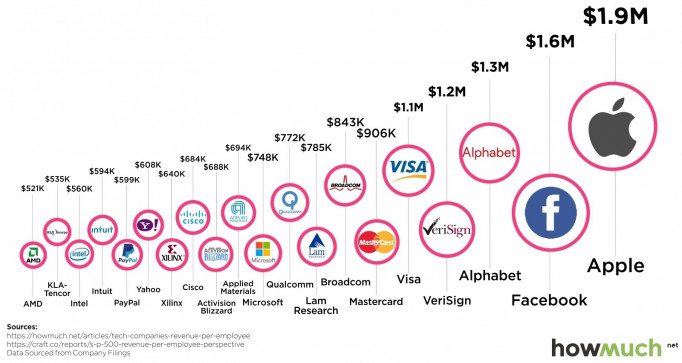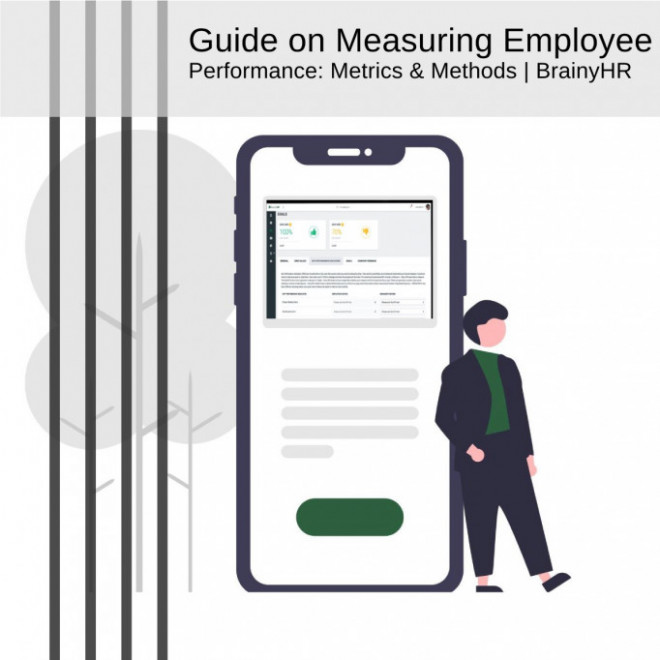Measuring employee performance usually causes stress for employees and HR managers. Many companies use performance metrics to measure employee review and satisfaction. Don't know how to stay calm when you conduct a performance review for your employees? Let's discuss the employee performance methods together with Brainy HR.
Better work, performance, production, successful employees - performance management summarizes all measures and activities that contribute to increasing the performance of individual employees.
Typically, performance management is controlled from HR and implemented operationally together with managers. Target agreements, appraisal interviews, and the associated measuring performance instruments are part of performance management. Performance-related remuneration, bonus systems, and other rewards such as trips or events can also be assigned to performance management.
Don’t know where to start? In this guide, you will find out the most used methods, metrics, and how to measure individual performance. Find out about effective ways for HR managers to do this!
5 easy steps for measuring employee performance
-
Do your research and choose the best practices
-
Be clear on your company goals for performance management
-
Establish your success performance review measures
-
Evaluation of your performance management system
-
Take action on the results
What is Employee Performance and Why Your Company Needs to Measure It?
Employee performance is simply a review of an employee's from a given period through a survey and interview. Such an assessment is carried out in companies regularly, usually at the end of the year or on the anniversary of each employee's work.
Performance review is one of the key stages of human resource management in a company. It allows HR departments to examine the performance results of employees, as well as recognize and diagnose problems within the organization, and then decide on possible training, promotion, or job reduction.
Performance was developed to increase the productivity of a company. In traditional corporate systems, performance management is always linked to the individual development of employees and their careers. It follows the motto: “Those who work well can also take on more responsibility.”
Measuring job performance is needed for HR people, line managers, and CFOs, CEOs, and CEOs to understand why HR is an essential foundation for any business. HR specialists now not only work with paperwork and execute administrative orders. They must present themselves as the leaders of the workforce. Professionals must conduct regular analyzes to help the company keep up with its competitors in its business activities.
Thanks to regular review and employee performance metrics, HR managers will not only evaluate the work of a given employee over time, but also look more broadly at the relations between employees and the condition of the entire company.
Types of Employee Performance Metrics
At first glance, all of these performance metrics seem complex for HR, which conduct review for the first time. But such control has a huge number of advantages, both for HR and the manager.
-
Metrics allow you to see the real picture of what is happening in the company.
-
With their help, you can find weaknesses in management, which are worth working on.
-
The HR manager receives objective information, which simplifies his process management.
-
The leader and the HR manager will find a common language better because they operate with real numbers.
Work quality metrics. Analysis of the productivity of the professional activity of an employee, an assessment of the fulfillment of the assigned tasks allows us to note the effectiveness of the functioning of the entire company. When assessing the effectiveness of the personnel, the following are useful:
-
amount of work performed;
-
the complexity of the tasks;
-
features of assigned functional duties;
-
the results of labor.
A person can cope with his duties, but never invest in deadlines, constantly distract colleagues to help with work, while efficiency is made up of two indicators:
-
Time spent on achieving results
-
Spent resources.
Work quantity metrics. The main criteria for assessing the productivity of duties are:
-
the final profit;
-
the personnel involved.
Profit levels don't guarantee the same performance for every employee. The assessment of the work of the entire team may not correspond to the assessment of an employee who “hides” behind colleagues and only “looks like” an effective employee. Specially developed assessment methods, aimed at determining the amount of the employee's efforts, his potential and external factors affecting his activities, help to determine the level of personnel performance.
Organizational performance metrics. To be distinguished, the purchased services arise through the use of temporary workers. Temporary workers are not employed by the company in which they are deployed. A famous example is the following infographic by Howmuch.net:

5 Performance Metrics to Evaluate Employee Performance
Performance metrics say something about the quality of the employee’s performance. The best-known metric is subjective appraisal by the direct manager, but how to measure employee performance and production metrics? We want to explain techniques to monitor individuals performance, which are very useful nowadays.
360-Degree Feedback
360 feedback is a method of assessing employee competencies in the work environment, made from many perspectives. Feedback can be provided by superiors, subordinates, co-workers, internal and external clients, and the assessed person. The process is confidential and anonymous, and the feedback obtained in this way is a valuable source of knowledge and can support planning your development.
What does a 360-degree evaluation do?
360-degree evaluation improves decision-making in many areas of the company's operation, including:
-
team building - assessment of individual employees allows you to diagnose team problems and better match its members,
-
assessment of the effects of work - allows you to better assess commitment and performance of tasks
-
evaluation of employee education processes - verification of trainings, courses and other skills development activities,
-
diagnosis of problems in the company - effective analysis of problems in a team of employees.
Human Capital ROI
The human capital ROI is a metric that assesses the value of human capital (i.e. knowledge, habits, and social and personal attributes). By calculating the company’s revenue (minus operating expenses and compensation and benefit-cost) and dividing this number by the total compensation and benefit-cost that the company pays its employees, you can calculate a human capital ROI.
This metric as described in the book by Dr. Jac Fitz-enz. He suggests the following actions: record keeping, task analysis, benchmarking, behavior analysis, and income forecasting. It should be noted that forecasting is about identifying the most valuable KPIs that serve as the basis for the successful implementation of a business strategy. Ironically, organizations with excellent data collection systems fail to effectively analyze the information they receive. The point is that decision-making plays a key role in the use of data.
Management by objectives
This metric can be calculated for various aspects of the company's operation: financial situation, production, sales, and also for the work of HR departments. The numerical description of the areas of personnel policy important to enterprises allows for the objectification of the effects of the work of HR departments. The use of indicators also allows managing the quality of work, because.
So what measures of goals should be set to serve the company and how to measure performance at work?
1. Measures must be related to the objectives of the processes, customer needs, and, most importantly, to the purpose of business, that is, what brings us benefits. Before we define the measures, we must define what we want to achieve in a given process, what the process client expects, and who is its supplier.
2. The key is simplicity, for example, using the SMART principle:
SIMPLE - clear, specific, legible - understandable and leaving no room for doubt
MEASURABLE - measurable - to objectively check whether it has been achieved
ACHIEVABLE - achievable, real - too "ambitious" and "distant" goal discourages
RELEVANT - important, important, valuable for the contractor
TIMELY DEFINED - timely, the execution time should be precisely specified
180-degree feedback
With 180-degree feedback, an employee is assessed by his superior, his colleagues (peers), and, if necessary, his customers. The main difference between 180-degree feedback and 360-degree performance appraisal is that it doesn't involve subordinates.
There are many reasons to use the 180-degree performance appraisal system, after all, it offers numerous advantages for both the company and the employee:
-
The 180-degree feedback questionnaire can be adapted to the culture and needs of the company.
-
This process does not end with the assessment itself, but continues with a continuous analysis. This is how HR professionals achieve the best results, especially when they complement this process with training and education activities.
-
Using this method creates credibility for the company.
-
Using evaluation systems shows that the company is interested in real performance improvement that promotes professional growth.
-
Organizations using evaluation methods see an immediate improvement in communication.
-
The appraisal interview is a great opportunity to give feedback and motivate the team.
Revenue per employee
Revenue per FTE = Total revenue / FTE
The revenue per employee provides a company with information about the success of individual employees. This knowledge can be used to compare the profitability of the company with competing companies in the same branch.
How to Measure Employee Performance and Production
These methods of employee performance measurement were developed by different product and software companies, so they are based on extensive practical experience. Measuring employee performance methods are very important for company growth, so they are divided into the following groups:
Simple ranking method
This is the construction of employee ratings according to a separate performance criterion: from best to worst. It is necessary when solving specific, narrow questions and is often combined with other methods.
Example of use: identifying a leader among managers of the department by the number of transactions per month or by total revenue. Useful for both annual and quarterly employee appraisals.
KPI method
At the beginning of the month, the employee is assigned tasks, on the completion of which (in percentage terms) his salary will depend, calculated at the end of this month.
Example of use: fulfilling the plan by 100% will bring the marketer an income of 50 thousand rubles. His monthly plan includes:
| Measure | Target | Factual | Criterion weight | Percentage of completion |
| Unique website visitors | 1 000 | 1 000 | 25 % | 25 % |
| Social media post with coverage of 500 users | 15 | 10 | 30 % | 20 % |
| Applications from the site | 30 | 20 | 45 % | 30 % |
As a result of the assess employee performance, our marketer fulfilled the plan by 75% and earned 50,000 x 0.75 = 37,500 USD in a month.
Assessment with ratings
Each completed task brings the employee a certain (predetermined) number of points. Monitor employee performance, at the end of the reporting period, usually a month, all points are summed up, and each team member takes his place in the overall performance rating.
Example use: Each finished turned part gives the machine operator ten points. At the end of the month, the results are summed up, and it becomes clear who is the most productive worker in the shop.
360 degrees
The efficiency of an employee's work is assessed by his colleagues, boss, clients, partners, contractors - everyone with whom he deals at work, as well as himself. This gives a complete picture of all the strengths and growth areas of the specialist.
Use case: An annual appraisal of the staff in a product company. Employees characterize the sales manager as a well versed professional - they all periodically contact him with questions about clients and specific tasks.
The manager is also pleased with the sales manager: according to him, this employee is responsible and efficient. In addition to his tasks as a salesperson, he sometimes takes on the functions of a store administrator. The 360-degree assessment shows that a sales manager may well qualify for the position of senior consultant or even an administrator.
Brainy HR employee performance software features
The appraisal interview can be difficult and stressful for HR managers.Employee performance measurement tools and techniques are very popular nowadays, usually, HR managers and company CEOs ask themself: how would I measure and maintain my performance? To complete the appraisal interviews, Brainy HR added a performance appraisal feature. If you don't have an HR department in your company, and need to conduct all reviews on your own - we can help you with this problem. The employee performance review is a feature that:
-
helps to control work and increases the efficiency of employees, and thus the entire organization;
-
supports the development of employees and increases their job satisfaction;
-
helps HR managers don't waste their time on boring paperwork and monitor staff performance methods;
-
helps build an organizational culture and improves communication in the company.
The most important advantages of modern software for your business include:
-
Reducing the time spent on preparing analyzes and reports, because the data needed to prepare them is easily accessible, up-to-date.
-
Automation of several repetitive operations. For example, cooperation with team lead or project manager.
-
Remember that even if there are only a few people in your company today, in the future, its number may double or even 10 times. Therefore, choose a system that can grow with your business.
-
If you have a lot of tasks, and sometimes forget what to do. You can configure the system and Brainy HR will send notifications on your Gmail.
Conclusions
Take a good look and help your business to become better, like the HR manager you need to try different employee metrics and choose most suitable for your employees and company. It is important to remember that a performance review is not a debriefing or a monologue of a manager! This is an equal dialogue between the manager and employee, the manager must listen and hear his employee.
The role of HR in the business environment has changed significantly over the past hundred years from an ordinary leader to the level of top management of an organization. To identify the strengths and weaknesses of the employees, as well as to communicate with them, you need to have an assessment software. The performance review is just such a tool through which you can assess the effectiveness ("performance") of a particular employee or a whole team. If you want to make the performance review process easier, just try to use Brainy HR!



 Posted on Aug 20, 2020 by Anna
Posted on Aug 20, 2020 by Anna


